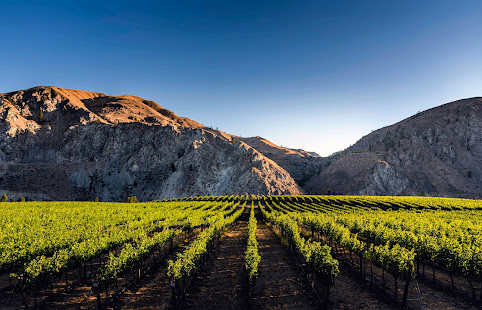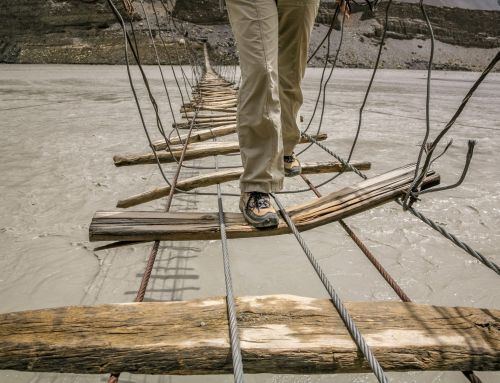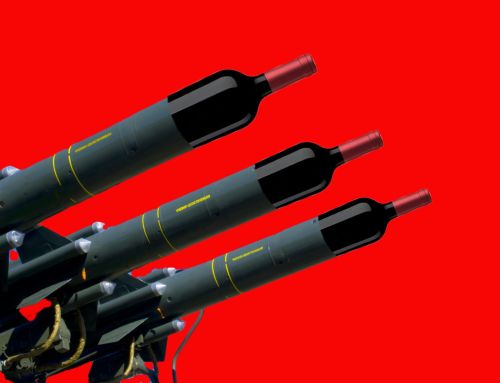Today the Tax and Trade Bureau (TTB) approved Washington’s newest appellation, Rocky Reach. The approval comes on the heels of three appellations last year, bringing the state’s total number of viticultural regions to 20. Here we take an in-depth look at the appellation.
Overview
Rocky Reach is located in the northwestern section of the Columbia Valley, just south of the Lake Chelan appellation. The appellation’s approval brings Columbia Valley’s number of sub-appellations to 16.
Rocky Reach gets its name from a term that steamboat captains used to refer to the stretch of rapids, or “reach,” in the Columbia River where Rocky Reach Dam is now located. Rocky Reach straddles the Columbia River, with 24% of the area occupied by the river and Rocky Reach Reservoir. The appellation is 32,333 total acres in size, with 117 acres currently under vine.
As a growing region, Rocky Reach has three key distinguishing features: its bedrock, its soils and flattop terraces, and its heat accumulation.
Metamorphic crystalline bedrock
Basalt is the ubiquitous bedrock throughout the Columbia Valley. Rocky Reach, however, is an exception.
“There’s no basalt bedrock within the boundaries of the AVA,” says VinTerra Consulting’s Kevin Pogue, who was contracted to write the appellation application by area growers. Instead, Rocky Reach is mostly granitic gneisses, or what geologists refer to as metamorphic crystalline bedrock.

“It has a very different chemical composition from basalt,” Pogue says of Rocky Reach’s bedrock.
Basalt is rich in minerals like iron, magnesium, and feldspar. In contrast, Rocky Reach’s bedrock is silica-rich and dominated by minerals like quartz and mica. Vines in the appellation that reach bedrock will therefore encounter a different suite of minerals. Lake Chelan is the only other appellation in Columbia Valley that shares this bedrock.
Cobblestone and gravel soils on flattop terraces
Rocky Reach’s soils also differ from those found elsewhere in Columbia Valley. They are composed of cobblestones and gravels overlaid by wind-deposited sand and silt.
Rocky Reach itself was never glaciated, but the area was heavily impacted by glacial outwash. The northern boundary of the appellation is the southern extent of the Okanogan Lobe of the Cordilleran ice sheet that channeled glacial ice down Okanagan Valley during the last ice age.

As the glacier retreated, the Columbia River reestablished its original course, cutting into the gravels. The last of the Missoula Floods, a series of cataclysmic floods that inundated the Columbia Valley over 15,000 years ago, further sculpted and eroded the valley. The results are soils and terrain that are quite different from other regions in Columbia Valley.
“There’s just an obscene amount of outwash or redeposited gravels and sands and cobble,” says Shane Collins, director of viticulture at Rocky Pond Winery.
Rocky Pond has its production facility – the only winery within Rocky Reach’s boundaries – and two vineyards in the appellation. Notably, the cobblestone and gravel soils are often on flat-topped terraces located near the canyon floor.
“It’s been a famous place for orchards for a very, very long time, and all the orchards and now the vineyards are taking advantage of these flat top terraces that sit on either side of the river,” says Pogue.

“Water moves through really, really quickly,” says Collins. “I’ve had to learn a lot about different water management strategies.” Rocky Pond has another vineyard, Rocky Reach, located next to the Columbia River that has a different soil profile.
“There’s three to six feet of beach sand that’s all blown in to this area,” says Collins. “It’s like a completely different world.”
More heat accumulation than surrounding regions
The final defining feature of the appellation is its heat accumulation. Elevations within Rocky Reach range from approximately 700 feet above sea level to just under 1,600 feet, considerably lower than surrounding areas. For this reason, Rocky Reach is markedly warmer.
“It’s the hottest place in that area,” says Pogue. This makes it well-suited to many red wine varieties. Areas right by the river can be extremely warm.
“Our Growing Degree Days on the river are about the same as Red Mountain believe it or not,” says David Dufenhorst, who owns Rocky Pond Winery with his wife Michelle. “So we get heat here.”
In terms of varieties, Pogue sees some natural fits. “The rocky soils and the warm temperatures, to me, screams Rhône.” While there are Rhône varieties planted in Rocky Reach, at present, Cabernet Sauvignon is the most planted variety, though there are more than 15 varieties planted.
Differences from Lake Chelan appellation

Rocky Reach also has a higher percentage of cobblestones and gravel. Soils in the Lake Chelan appellation meanwhile are deeper, have more glacial till, and are not on flood terraces.
“The soils are not as loamy [as Chelan] and are much better drained,” Collins says comparing Rocky Reach to the Lake Chelan appellation. The two appellations also have differences in heat accumulation.
“It’s warmer than Chelan, actually significantly warmer,” says Alex Kelly, who manages Pierre Vineyard in the appellation. The heat impacts what can be grown in Rocky Reach and also results in significant differences in the wines compared to Chelan.
“I taste things that are similar in terms of the phenolics to warmer regions to the south that I don’t think I got at all from the Chelan AVA,” says Collins.
A young growing region
While Rocky Reach has long been known for its orchards, the area’s first vineyard plantings were in 2010. In 2015, the Dufenhorst family began planting Double D Vineyard. The name is a callout to his family’s long history of people with two Ds in their name. At 65 acres, it is by far the largest vineyard within the appellation and more than half of the currently planted acreage.
“The first 30 acres we planted was fallow land,” says Dufenhorst. “It had never been planted with fruit trees because it was so rocky. I was holding my breath that anything would grow.” The initial vines did well, and the vineyard has now been expanded, with additional acreage planned.
Dufenhorst, who moved to the area to retire after a career in real estate, purchased the land from the Pierre family. The Pierre family also has a home, a 14 acre vineyard, and other acreage in the appellation. Jamie Pierre, who passed away in January of 2021, was one of the driving forces for the area becoming its own appellation.
“As often happened with Jamie, he absolutely lucked into the best wine ground that you could imagine,” chuckles Kelly, his son-in-law. “He had a knack of doing that.”
Grand plans for Rocky Reach’s future

Meanwhile the Pierre family is currently growing grapes for sparkling wine, part of Jamie’s promise to his wife Barbara. They are also growing head-trained Grenache on the terraces. Much like in Walla Walla Valley’s Rocks District, Kelly says farming in Rocky Reach is no easy venture.
“It’s rough on people,” Kelly says. “It’s all cobbles on top. Farming those terraces is pretty much [with] backpacks and huffing and puffing back and forth, but what we’re getting from it is pretty amazing.” Ray Sandidge (C.R. Sandidge) is currently making the wines, though there are no immediate plans to release them.
“We want to make the best product that you can put into the market,” Kelly says. “And if it takes a little time to get there, that’s what we’re doing.”
Meanwhile along with their current vineyard acreage, the Dufenhorsts own 90 additional acres, with plans to build a hotel, spa, and restaurant. The project is currently in the planning stage.
“I think we really have something special here, but it took a lot of work to get it to where it is now,” says Dufenhorst. “But being in business 30 years, anything good that you want to do generally takes a lot of time, a lot of effort.” Collins agrees and notes that, even with the appellation’s approval, there is much more work to be done at Rocky Reach.
“I think there’s a lot of potential for this region for people to come here and plant grapes. But we’re still at the very beginning.”
Images by Richard Duval, except image of Rocky Reach cobblestones, copyright Kevin Pogue. Figures from AVA application. Figure 9 – Crystalline basement bedrock in Rocky Reach and northern Columbia Valley. Figure 5 – Southern terminus of Okanagan Lobe of the Cordilleran ice sheet, leading to glacial outwash in the current day Rocky Reach appellation. Washington appellation graphic courtesy of the Washington Wine Commission.
NB: This post has been updated to correct the minimum elevation of Rocky Reach, 700 feet.








Peter Young> it appears to be a small AVA. both sides of the Columbia River? Is Wenatchee in the AVA? What about Martin Scott winery? I'm struggling to grasp the exactness of the AVA/
Hi Paul, I'm not sure if you can see the map or not in the post, but Rocky Reach is between the Lake Chelan AVA and Wenatchee, with both outside of the AVA boundaries. It is shown in red on the map. Rocky Pond is the only winery within the AVA boundaries, so Martin Scott is outside the boundaries to the south. You can see a full map of Washington's AVAs here. Let me know if you have additional questions.
https://www.washingtonwine.org/resource/washington-state-ava-map/
It looks like there might be a typo with the AVA elevations. Assume the lower was supposed to be “700” not “70”?
Correct. Thank you for the catch.